 |
 |
|
 |
 |
Pentax K-7, K-5, K-3 APS-C:
2009-2010: Pentax K-7:
After a slow entry into the digital world, with the *ist D followed by the promising K 10 D and K 20 D series, another new step was taken with the K-7 in 2009. It was the same sensor as on the K 20D, but most of the rest was renewed. Most of all the
body, which was made even more compact: from 141,5x101x70 to 130,5x96,5x72,5. And weight was reduced by some 40 grams to 670 grams empty. The K-7 was given very positive remarks for image quality. Dark conditions could leave some noise, though.
 More compact than the predecessors. AF, called SAFOX VIII+, was faster than K 20D, but still lacking the edge towards other top models.
More compact than the predecessors. AF, called SAFOX VIII+, was faster than K 20D, but still lacking the edge towards other top models.
 Recognizable from the K 10/20D.
Recognizable from the K 10/20D.
 Green button is moved to the back, while over/under compensation and ISO buttons were moved up.
Green button is moved to the back, while over/under compensation and ISO buttons were moved up.
 Added video mode for the first time.
Added video mode for the first time.
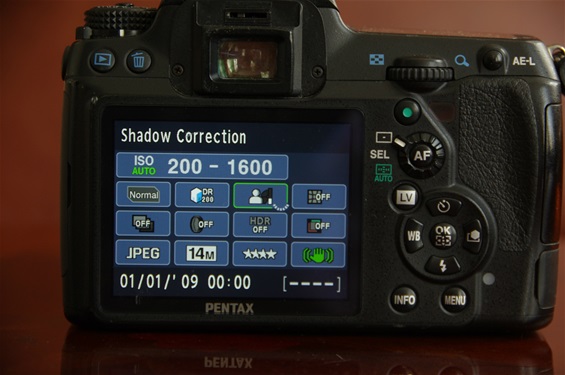 Redesigned control panel with a bigger LCD screen, 3 inch 921.000 pxls.
Redesigned control panel with a bigger LCD screen, 3 inch 921.000 pxls.
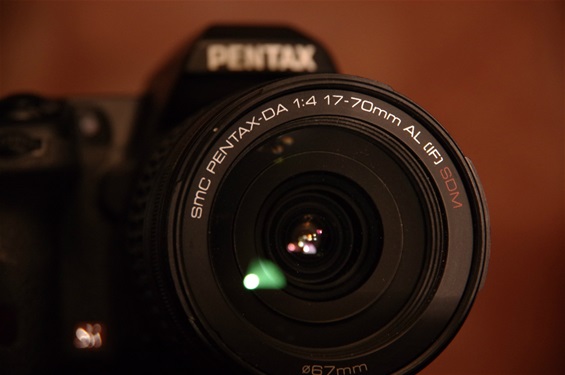 DA 17-70 AL (IF) SDM of 2008. Optically very good, but the SDM here is known for a hunting AF, especially at 70. Can sometimes drive you mad. Sn. 6409527.
DA 17-70 AL (IF) SDM of 2008. Optically very good, but the SDM here is known for a hunting AF, especially at 70. Can sometimes drive you mad. Sn. 6409527.
Later models during the K-7 era: 2009-2010: K- x (Introduction model.) 2010-2011: K- r (New introduction model.)
2010-2013: K-5:
The K-5 of October 2010 introduced a new Sony CMOS sensor of 16,3 megapixel. The image quality was highly praised.
 Following the K-7 in body and most functions. Improved AF with SAFOX IX. The K 5 was almost identical to K 7 on the outside, but came with a new CMOS sensor of 16,3 MB that was judged to be even better tuned than the one of the Nikon 7000 released at the same time and using the same Sony sensor. And the ISO value reached 51 200, with tolerable results up to 12 800. The K 5 nearly got the Camera of the Year award. It might very well have won it, but that may have been too much for the jury as the new Pentax 645 D won the title in the Pro Camera division. Size: 130,5x96,5x72,5. Weight: 660 grams. Sn: 4300623.
Following the K-7 in body and most functions. Improved AF with SAFOX IX. The K 5 was almost identical to K 7 on the outside, but came with a new CMOS sensor of 16,3 MB that was judged to be even better tuned than the one of the Nikon 7000 released at the same time and using the same Sony sensor. And the ISO value reached 51 200, with tolerable results up to 12 800. The K 5 nearly got the Camera of the Year award. It might very well have won it, but that may have been too much for the jury as the new Pentax 645 D won the title in the Pro Camera division. Size: 130,5x96,5x72,5. Weight: 660 grams. Sn: 4300623.
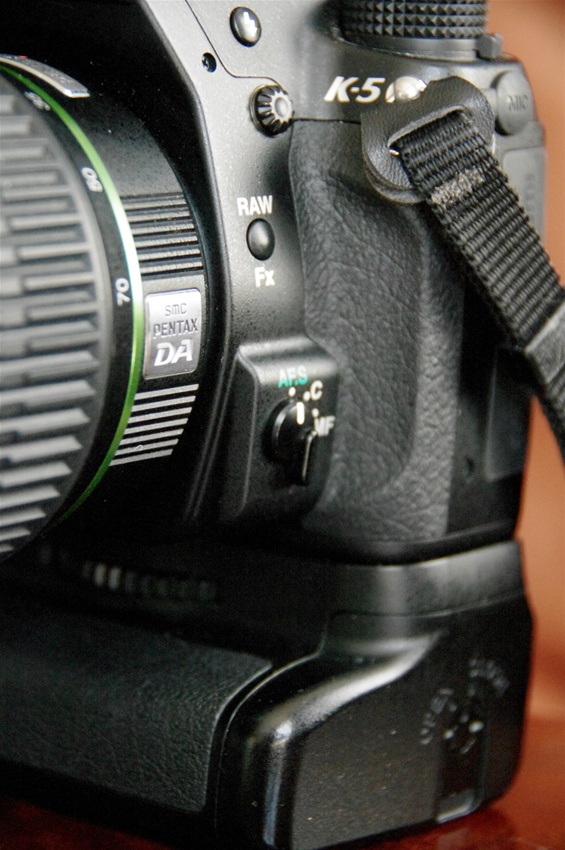 Following a well functioning pattern, but adding a new function: the RAW button is customized, giving a variety of functions, such as meter bracketing.
Following a well functioning pattern, but adding a new function: the RAW button is customized, giving a variety of functions, such as meter bracketing.
 Controls identical to the K-7 both on top..
Controls identical to the K-7 both on top..
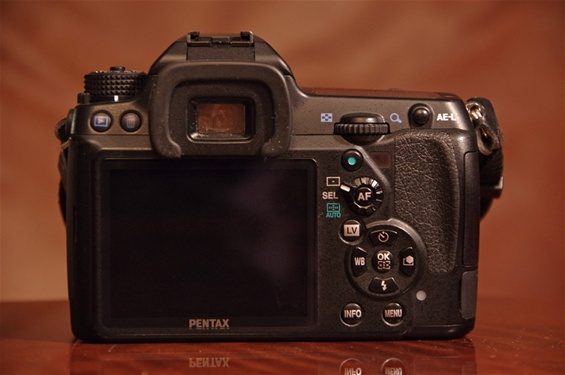 and on the back.
and on the back.
 The same LCD screen as on the K-7, with 3 inch 4:3 size and 921.000 pxls. But ISO was now up to 51.200, and generally the noise problem of the K-7 was solved.
The same LCD screen as on the K-7, with 3 inch 4:3 size and 921.000 pxls. But ISO was now up to 51.200, and generally the noise problem of the K-7 was solved.
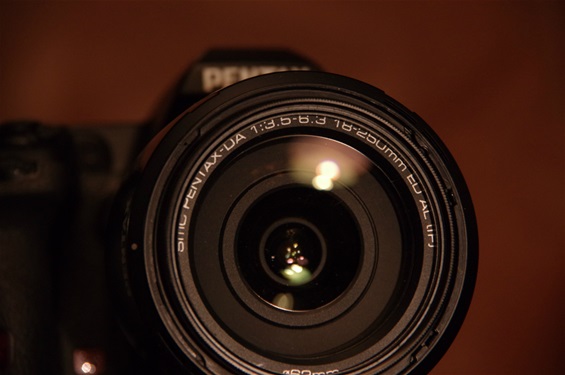 From 2007: A DA 18-250 3,5-6,3 EV AL (IF). Surprisingly good for the range and the price. Sn. 9082658.
From 2007: A DA 18-250 3,5-6,3 EV AL (IF). Surprisingly good for the range and the price. Sn. 9082658.
Other models connected to the K-5 series: 2012-2013: K-30 (New medium range camera) 2012-2013: K-5 II and K-5 IIs (Improved successors of K-5) 2013-2016: K-50 to replace K-30 (16 MB, WR) 2013-2014: K-500 as new entry level
camera, less advanced.
2013-2016: Pentax K-3:
On October 8th 2013 the new Pentax K-3 is announced. Less than one month later it is in my hands.
In short, the K-3 advantages over the K-5 family is: -A 24 MB sensor versus 16 MB.
-8,3 frames per second versus 7 f/s.
-A 27 point AF versus 16:
-EV-3 to 20 metering system with 86.000 pixel sensor.
-3,2 " LCD panel in 3:2 size versus 3" 4:3.
-92 weather seals versus 72. Winner of EISA-prize 2014-15.
Winner of TIPA-prize 2014. (Best Expert Camera.)
Fore more details, see under.
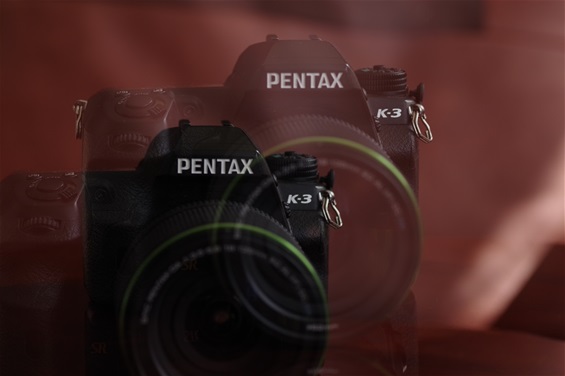 Another step for Pentax, now up to 24 mp on an APS-C sensor camera. As on the K-5 IIs, the Anti Alias filter is removed, but on the K-3 you still have the opportunity to remove moire through internal SR, a system not available on other makes. This combination of more pixels and no filter gives even higher resolution and sharper big prints. But critics fear it will also tend to produce more noise. My experience, so far, is that it ain't necessarily so. Compared to the K-5 it follows pretty much the same line. AF is far better with the new SAFOX XI. Even under dark conditions it it gets it right. Ergonomics feel even better. My Pentaxes have all been good in that respect, and the K-3 feels perfect even before I have tried it with the battery grip. So, in short, this is the best picture machine Pentax has ever made. For those in need of a camera to shoot fast and get it right, this is the one. For those spending hours to seek the ultimate subject to take the ultimate picture, the technicalities of any camera has little to do with it.
Size: 131,5x100x77,5 mm. Weight: 715 gr nto, 800 gr with card and battery. Sn. 4829143.
Another step for Pentax, now up to 24 mp on an APS-C sensor camera. As on the K-5 IIs, the Anti Alias filter is removed, but on the K-3 you still have the opportunity to remove moire through internal SR, a system not available on other makes. This combination of more pixels and no filter gives even higher resolution and sharper big prints. But critics fear it will also tend to produce more noise. My experience, so far, is that it ain't necessarily so. Compared to the K-5 it follows pretty much the same line. AF is far better with the new SAFOX XI. Even under dark conditions it it gets it right. Ergonomics feel even better. My Pentaxes have all been good in that respect, and the K-3 feels perfect even before I have tried it with the battery grip. So, in short, this is the best picture machine Pentax has ever made. For those in need of a camera to shoot fast and get it right, this is the one. For those spending hours to seek the ultimate subject to take the ultimate picture, the technicalities of any camera has little to do with it.
Size: 131,5x100x77,5 mm. Weight: 715 gr nto, 800 gr with card and battery. Sn. 4829143.
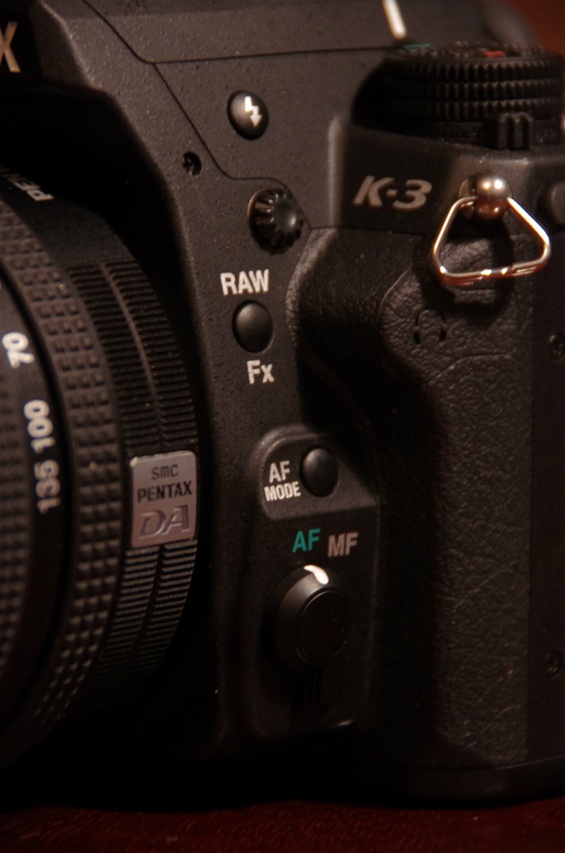 Some changes from earlier types: The AF switch has two options: AF or Manual. AF mode is operated by a button that lets you into a menu to choose AF mode with the rear dial at the upper back.
Some changes from earlier types: The AF switch has two options: AF or Manual. AF mode is operated by a button that lets you into a menu to choose AF mode with the rear dial at the upper back.
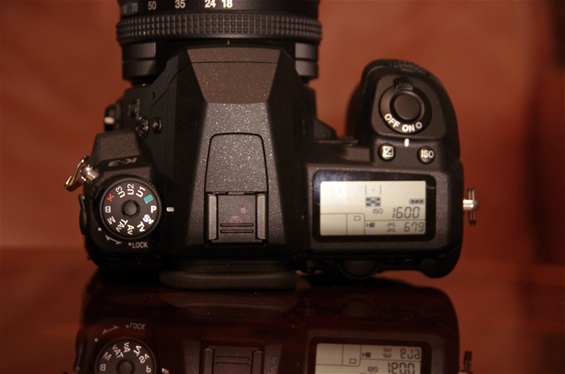 Controls on top are as before, except the new User mode options. Used to be one, some others have two. K-3 has three.
Controls on top are as before, except the new User mode options. Used to be one, some others have two. K-3 has three.
 The rear LCD panel have increased a bit, from 3 inch to 3,2. More important is the change in format, now following the 36:24 (3:2) format of the 35 film. The information panel gives everything you would need to know.
And yes, it says Ricoh under the panel. Annoyingly clear. On the other hand: Ricoh deserves the credit for taking up the struggle against The Big Three: Canon, Nikon and Canon..
The rear LCD panel have increased a bit, from 3 inch to 3,2. More important is the change in format, now following the 36:24 (3:2) format of the 35 film. The information panel gives everything you would need to know.
And yes, it says Ricoh under the panel. Annoyingly clear. On the other hand: Ricoh deserves the credit for taking up the struggle against The Big Three: Canon, Nikon and Canon..
A red button to open Live View.
A handle to select still or video. A button to select memory card 1 or 2.
Some changes: Lock or open mode dial. Selecting metering system is now on the button that also deletes pictures. (You will not delete by mistake!)
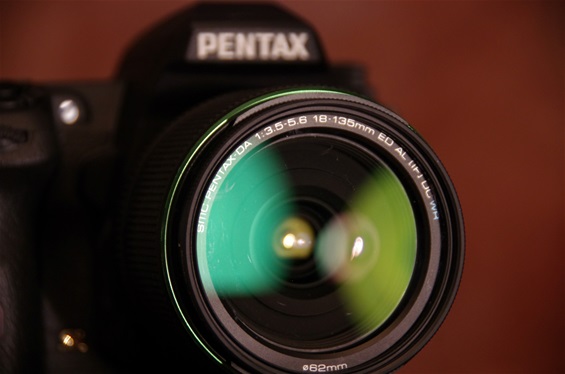 Released as Weather Resistant in 2013: the SMC DA 18-135/3,5-5,6 ED AL (IF) DC WR. A sharp lens with a practical range. Will soon become your favorite zoom. Sn. 9003760.
Released as Weather Resistant in 2013: the SMC DA 18-135/3,5-5,6 ED AL (IF) DC WR. A sharp lens with a practical range. Will soon become your favorite zoom. Sn. 9003760.
CAMERA HARDWARESENSOR | Type | CMOS w primary color
filter and integrated Shake/Dust Reduction sensor movement system | | Size | 23.5 x 15.6mm | | Color depth | 8 bits/channel JPG, 14 bits/channel RAW | | Effective
pixels | 24.35 MP | | Total pixels | 24.71 MP | | AA Filter | No (the AA filter effect can be simulated with the SR mechanism) | | Still resolution |
Jpeg: L (24M:6016x4000), M (14M: 4608x3072), S (6M: 3072x2048), XS (2M: 1920x1280) | | RAW resolution | L (24M:6016x4000) | | Quality levels | *** Best, ** Better, * Good, RAW (14-bit) |
| Movie resolution/FPS | Full HD (1920x1080, 60i/50i/30p/25p/24p) | | | HD (1280x720, 60p/50p/30p/25p/24p) | | Dust Removal | DR II (ultrasonic
vibration to low pass filter) with Dust Alert function | LENS MOUNT | Type/construction | PENTAX KAF2
bayonet stainless steel mount | | Usable lenses | PENTAX KAF3, KAF2, KAF, and KA | | Usable with restrictions | K mount | | Usable with adapter and restrictions |
35mm screwmount, 645/67 medium format lenses | | SDM function | Yes | | Power zoom function | Yes (power zoom only) | FOCUS SYSTEM | Type | SAFOX 11 TTL phase-matching - 27 point (25 cross type focus points in the center) | | Focus modes | AF Single
(w focus lock, focus/shutter priority selectable), AF Continuous (w focus/FPS priority selectable), Manual | | Focus point adjustment | Spot, Select, Expanded Area (S, M, L), Zone select, Auto (27 AF points) |
VIEWFINDER | Type | Pentaprism | | Coverage (field of view) | 100% | | Magnification | 0.95X (w 50mm F1.4 at infinity) | | Standard focusing screen | Natural-Bright-Matte III (interchangeable) | | Diopter adjustment | -2.5m to 1.5m |
| Depth of field preview | Optical (diaphragm stop-down), Digital | LCD MONITOR
| Type | 3.2 inch TFT color LCD with brightness/saturation/color adjustment AR coating and air-gapless glass | | Resolution | 1037K dots | | Aspect ratio | 3:2 | | Wide angle viewable | Yes | LIVE VIEW | Type | TTL by CMOS image sensor |
| Field Of View | Approx.100% | | Display Modes | Magnification (2-6X AF, 2-10X MF), Grid Overlay (4x4, Golden Ratio, Scale), Bright/Dark Indication, Histogram |
| Autofocus | Yes, Contrast + Face Detection, Contrast Detection, Phase Difference | BUILT-IN FLASH
| Type | Retractable P-TTL popup flash | | Guide number | 13m (ISO 100) | | Coverage | 28mm wide angle (equiv 35mm) | | Flash modes | Auto,
On, Redeye, Slow Sync, Slow Sync + Redeye, Trailing Curtain Sync, High-speed sync, Wireless, Manual | | Flash exposure compensation | -2 to 1 EV (1/2 steps) | EXTERNAL FLASH | Type | Hotshoe (P-TTL), high speed sync and wireless w PENTAX dedicated flash, X-Sync Socket | | Synchronization speed |
1/180 sec | STORAGE MEDIA | Internal memory | n/a | | Removable memory |
SD, SDHC, SDXC, EyeFi, FLU Card | INTERFACES | Ports | USB 3.0 hi-speed, headphones, HDMI out,
DC in, cable switch, 3.5mm stereo microphone, X-sync socket | | Video out | HD (via HDMI), NTSC, PAL | | Printer interfaces | n/a | POWER SUPPLY | Power source | Rechargeable Li-Ion battery D-LI90 | | | D-BG5 Battery Grip (optional) with trays for 2nd D-Li90
battery or 6x AA batteries | | Recordable images | Approx 720 (approx 560 w 50% flash, CIPA) | | Playback time | Approx 370 min | | Movie recording time |
Approx 25 min (automatic overheat shutdown protection) | | AC adapter available | Yes - (optional) K-AC132 | PHYSICAL SPECIFICATIONS | Body dimensions (W x H x D) | 131.5 x 100 x 77.5 mm / 5.17in x 3.94in x 3.05in | | Body weight | 715g / 25.2 oz (without battery or SD card), 800g / 28.2
oz (loaded and ready) | | Construction materials | Magnesium alloy shell over metal chassis | | Weather resistant | Yes (92 special sealing parts) | | Operating
temperature | 14-104°F (-10 to 40°C) | IMAGE CAPTUREIMAGE STABILIZATION
| Type | Sensor-Shift Shake Reduction with rotational compensation | | Electronic level function | Yes, verification via viewfinder and LCD panel | METERING
SYSTEM | Type | TTL open aperture metering using 86K pixel RGB sensor | | Sensitivity range | EV -3 to 20
(ISO 100, 50mm F1.4) | | Multi-Segment | Yes | | Center weighted | Yes | | Spot | Yes | | Exposure compensation | +/-
5 EV (1/3 and 1/2 steps) | | Exposure lock | Yes | | Exposure bracketing | Yes (2, 3, or 5 frames, up to +/- 2 EV in 1/3 or 1/2 steps) | ISO SENSITIVITY | Auto | ISO 100-51200 (1, 1/2, 1/3 steps), Auto ISO range selectable, | | Bulb mode | Auto ISO n/a |
| Manual | 100-51200 (1, 1/2, 1/3 steps) | WHITE BALANCE | Auto modes | AUTO WB, Multi Auto
WB | | Presets | Daylight, Shade, Cloudy, Fluorescent Light (D: Daylight Color, N: Daylight White, W: Cool White, L: Warm White), Tungsten Light, Flash, CTE | | Manual modes | Manual WB
(up to 3 settings), Color Temperature Configuration (up to 3 settings), Copying the white balance setting of a captured image | | Note | White Balance fine adjustment available in all modes | SHUTTER | Type | Electronically controlled, vertical-run, focal plane shutter | | Shutter speed |
1/8000 to 30 sec (1/3 or 1/2 EV steps), Bulb | CAPTURE MODES | Mode selection | Green, Hyper Program
(P), Sensitivity Priority (Sv), Shutter Priority (Tv), Aperture Priority (Av), | | | Shutter & Aperture Priority (TAv), Metered Manual, Bulb, X-Speed, USER (3 presets). | | Custom
Image Modes | Bright, Natural, Portrait, Landscape, Vibrant, Radiant, Muted, Bleach Bypass, Reversal Film, Monochrome, Cross Processing | | | - All include gamut radar and fine adjustment of saturation, hue,
high/low key, contrast, and sharpness (regular and fine adjustment scales). | | | - Monochrome mode includes adjustments for filter effects (green, yellow, orange, red, magenta, blue, cyan, infrared), toning (sepia,
warm/cool), high/low key, contrast, and sharpness (regular, fine, and extra sharp adjustment scales) | | HDR | Auto, HDR1, HDR2, HDR3, Exposure Bracket Value adjustable, Automatic composition correction function |
| Green simplified mode available | Yes | | P/A/S/M/B | P, A, S, M, B (extended modes Sv, TAv) | | Date stamp | n/a | | Digital
filters (capture) | Extract Color, Toy Camera, Retro, High Contrast, Shading, Invert Color, Unicolor Bold, Bold Monochrome | | Data record | Folder name (standard, date), file name (standard, customizable), embed
copyright | DRIVE MODES | Mode selection | Single, Continuous (H,M,L), Self-Timer (12s, 2s), Remote
(0s, 3s, continuous), | | | Exposure Bracketing (standard, timer, remote), Mirror up (standard, remote), | | | HDR Capture (3 shots at 1EV, 2EV, or 3EV, 3 blend settings
plus Auto, pixel alignment) | | Multi-exposure | Composite Mode (Additive/Average/Bright) Number of Shots (2 to 2000 images), | | | Interval 2000 shots, 2 sec to 24 hrs, time delay
available) | | Continuous FPS | H: Approx 8.3 FPS (60 JPG, 23 RAW) | | | M: Approx 4.5 FPS (100 JPG, 32 RAW) | | | L: Approx 3.0 FPS (200
JPG, 52 RAW) | | Self-timer | Yes (12s, 2s) | | Remote control | Yes, infrared (0s, 3s, continuous), cable switch | PLAYBACK MODES | Mode selection | Single frame, multi-image display (6,12, 20, 35, 80 segmentation), display magnification (up to 16, 100% display and quick magnification
available), rotating, histogram (Y histogram, RGB histogram), bright area warning, Auto Image Rotation, detailed info, Copyright Information (Photographer, Copyright holder), Folder Display, Calendar Filmstrip Display, Slide Show Mode pallet, Image Rotation,
Digital Filter, Resize, Cropping, Slideshow, Save as Manual WB, RAW Development, Index Print, Protect, Movie Edit, Extract JPG from Movie, Magnification: up to 16X, scrollable, quick magnification | | Digital filters (playback) |
Base Parameter Adj, Extract Color, Toy Camera, Retro, High Contrast, Shading, Invert Color, Unicolor Bold, Bold Monochrome, Tone Expansion, Sketch, Water Color, Pastel, Posterization, Miniature, Soft, Starburst, Fish-eye, Slim |
FILE FORMATS | Still | RAW (PEF, DNG), JPG (EXIF 2.30), DCF 2.0 compliant | | Movie | MPEG-4
AVC/H.264(MOV) | | Interval movie | JPEG(AVI) | CUSTOM FUNCTIONS OTHERCOMPUTER SYSTEM REQUIREMENTS (For device connectivity. Bundled software requirements may vary) | Windows | Windows 8 (32 bit/64 bit) / Windows 7 (32 bit/64 bit) / Windows Vista (32 bit/64 bit), Windows XP SP3 (32 bit) | | Mac | Mac OS X 10.8
/ 10.7 / 10.6 | LANGUAGE SUPPORT | English, French, German, Spanish, Portuguese, Italian, Dutch, Danish, Swedish, |
| Finnish, Polish, Czech, Hungarian, Turkish, Greek, Russian, Korean, | | Chinese (Simplified/Traditional), Japanese | Specifications are subject to change.
Megapixels:24.0ISO Range:100-51200Weight:800gFPS:8.3LCD:3.2"In Production:Type:Advanced DSLRWeather Sealed:Yes
Read more at: http://www.pentaxforums.com/camerareviews/pentax-k-3.html#ixzz2l25O6k9i
Comparing the three on Pentax Forum:
| Verdict by Pentax users:
| | | | | | K-7 | K-5 | K-3 | | | | | |
| ergonomics | 9,2 | 9,3 | 9,0 | | build quality | 9,4 | 9,7 | 9,8 |
| user interface | 8,7 | 9,1 | 8,8 | | autofocus | 7,2 | 8,1 | 9,0 |
| features | 8,6 | 9,3 | 9,7 | | image quality | 8,1 | 9,5 | 9,5 |
| noise | 6,7 | 9,2 | 8,5 | All in all, the K-3 is a small step ahead of K-5, leaving K-7 way behind.
(57,9 - 64,2 - 64,3 points respectively)
My comments:
I feel K-3 ergonomics a a small step up from earler Pentaxes, being very good already. 9,4. User interface is better than on K-5, with faster LV and video access. 9,2.
Noise is hardly more noticable on K-3 than on K-5. 9,2. Or rather 9,0 for both. In general, K-7 is rated too low.
K-5 was a step up from K-7, mostly due to less noise. Points are too low for K-7 on build quality
(9,6), user interface (9,0), features (9,0), and image quality (8,8).
Which gives the following points: 59,5 - 64,0 - 65,6. (Or average: 8,5 - 9,1 - 9,4).
Other cameras under the K-3 era:
Other cameras under the K-3 era: 2014-2016: Pentax K-S1 (20 MB, WR, medium range) 2015-2017: Pentax K-S2 (Improved successor of K-S1) 2015-2018: Pentax K-3 II (Improved successor of K-3. The new top model in APS-C range.) 2016-:
Pentax K-70 (With K-50 and K-500 discontinued, this is the new advanced step-in model.) 2017-: Pentax KP (As K-3 and K-3II were discontinued, this is the top APS-C model until new K-?)
2021: Pentax K-3 III (New APS-C flagship model. Substantial
improvements. Highly praised.)
Improving the winner of EISA 2014-15 and TIPA 2014!
APS-C top model
The Pentax K-S2, winner of TIPA prize 2015.
APS-C advanced range.
New flagship APS-C after K-3 II was discontinued.
Highly praised new flagship APS-C model.
|
|
 |
|
|
|